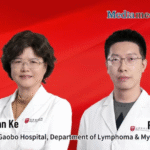
The 54th Annual Scientific Meeting of the International Society for Experimental Hematology (ISEH 2025) was held in Kumamoto, Japan, from September 24 to 27. The event brought together leading global experts to discuss cutting-edge advances in basic hematology, immunology, stem cell biology, and cellular and gene therapies. One of the highlights of the meeting was the China–Japan Joint Symposium on Stem Cell and Cell Therapy, which drew significant attention. Professor Xue Feng from the Institute of Hematology and Blood Diseases Hospital, Chinese Academy of Medical Sciences (CAMS), delivered an insightful presentation titled “Adeno-Associated Virus Vector Expressing Factor IX Padua in Treating Hemophilia B in China.” Following the presentation, Oncology Frontier – Hematology Frontier conducted an exclusive interview with Professor Xue to explore this innovative approach and its future clinical prospects. Current Status and Unmet Needs in Hemophilia B in China
Oncology Frontier – Hematology Frontier: Professor Xue, could you first give us an overview of the prevalence of hemophilia B in China? What challenges and unmet needs remain under current treatment options?
Prof. Xue Feng: According to the National Hemophilia Registry, there are over 8,000 patients with hemophilia B in China, including more than 6,000 with moderate-to-severe disease. These patients often experience significant bleeding symptoms. Current treatment for hemophilia B in China remains suboptimal. Traditional therapy relies mainly on prothrombin complex concentrates (PCCs), which provide factor IX but also contain factors II, VII, and X, posing potential long-term safety risks with repeated use. In recent years, plasma-derived factor IX products have gradually become available, but they are only approved for on-demand treatment. Recombinant products are extremely expensive, and medical insurance coverage is limited to on-demand treatment for adults and either prophylactic or on-demand treatment for children. As a result, the majority of moderate-to-severe patients remain undertreated, contributing to persistently high rates of disability.
Research Progress: AAV Vector Gene Therapy
Oncology Frontier – Hematology Frontier: At this symposium, you presented research on AAV vector-mediated gene therapy expressing factor IX Padua. Could you explain the core mechanism of this strategy and the key results shared?
Prof. Xue Feng: Before explaining gene therapy, it is important to briefly review the pathophysiology of hemophilia B. The condition is caused by mutations in the factor IX gene, preventing hepatocytes from producing functional factor IX — like a factory missing the correct blueprint. Gene therapy delivers a functional copy of the factor IX gene into hepatocytes, enabling them to produce functional protein and restore normal coagulation.Our work focuses on liver-targeted gene therapy using adeno-associated virus (AAV) as the delivery vector. AAV carries the functional factor IX gene to the liver. Clinical studies have shown that after a single infusion, most patients achieve a significant and sustained increase in factor IX levels — enough to prevent spontaneous bleeding and even to control bleeding after trauma — bringing their coagulation function close to or within the normal range. Notably, some patients have now been followed for nearly six years, and their factor IX activity remains stable, demonstrating durable long-term benefit.
Transformative Value and Future Directions
Oncology Frontier – Hematology Frontier: How do you see this new therapy reshaping the treatment paradigm for hemophilia B in China? What are your next steps in this research?
Prof. Xue Feng: Gene therapy represents a revolutionary breakthrough in hemophilia care. Unlike traditional treatments requiring repeated intravenous or subcutaneous infusions, gene therapy offers the possibility of a one-time treatment with lasting benefit, dramatically improving quality of life. From a health economics perspective, its long-term effect may lower overall healthcare costs, making it highly cost-effective. Therefore, for eligible patients, we recommend prioritizing gene therapy when possible.In practice, however, we have seen that some patients cannot receive AAV-based therapy due to pre-existing neutralizing antibodies against AAV. Under the leadership of Professor Zhang Lei, our team is actively investigating new strategies to overcome this limitation, with the goal of expanding eligibility so that patients with anti-AAV antibodies can also benefit. If successful, this would greatly broaden the population who can receive gene therapy.
Expert Profile

Professor Xue Feng- Chief Physician and Master’s Supervisor, Hemostasis and Thrombosis Center, Institute of Hematology & Blood Diseases Hospital, CAMS
– Deputy Head, Rare Disease Group, Hematology Branch, Chinese Medical Association- Deputy Secretary-General, Hemophilia Group, China Alliance for Rare Diseases
– Executive Chairman, Chinese Hemophilia Youth Collaboration Group
– Standing Committee Member, Hemorrhage Professional Committee, Chinese Research Hospital Association- Board Member, Tianjin Society of Hematology & Regenerative Medicine- Member, Hematology Branch, Tianjin Medical Association
– Youth Editorial Board Member, Journal of Rare Diseases- Executive Editorial Board Member, Thrombosis and Hemostasis
– Corresponding Editorial Board Member, Journal of Clinical Internal Medicine- Principal Investigator, National Key R&D Program Projects and NSFC Grants
– Winner, First Prize for Tianjin Science and Technology Progress Award (2023)- Published multiple papers in NEJM, Lancet Haematology, JTH, AJH, and other leading journals

